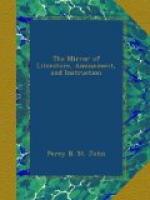The Bavarian is straight-forward, frank but dry, blunt, and he has hitherto been ruder, more ignorant, more fond of quarrel and drinking, more given up to superstition and old things than others; for his land was the home of priestcraft and monkery. You may ever distinguish the national Bavarian by his nervous squat body, small round head, and beer-belly, immediately beneath which the trousers begin; hence the braces or belt is indispensible. The showy belt, is, as in the Tyrol, matter of national pomp, so with the girls the boddice; and both are as little known in the north as the platted hair of the maidens—perhaps relics of the knight’s girdle, bandalier, and breastplate; for noble knighthood flourished chiefly in the south.
* * * * *
SPIRIT OF DISCOVERY.
* * * * *
GEOGRAPHICAL.
The Niger.
Sir Rufane Donkin’s new hypothesis respecting the Nile, briefly stands thus: The Niger (Ni-Geir) passes through Wangara, and emptying itself into the Wad-El Ghazeh, or Nile of Bornou, which is formed by the continuation of the Misselad (Geir) through Lake Fittre, flows under the sands of Bilmah into the Mediterranean Sea. Sir Rufane is likewise of opinion—that “reasoning from analogy, and still more from what we know of the nature of the country, I have no doubt but that in very remote ages, the united Niger and Geir did roll into the sea in all the magnificence of a mighty stream, forming a grand estuary or harbour where now the quicksand is.”—“The question to be solved under such a supposition is, what revolution in nature can have produced so great a change in the face of the country, as to cause a great river which once flowed into the sea, to stop short in a desart of sand.” “We know from all recent, as well as from some of the older modern travellers, that the sands of the desarts west of Egypt, are encroaching on, and narrowing the valley of the Nile of Egypt. We see the pyramids gradually diminishing in height, particularly on their western sides, and we read of towns and villages which have been buried in the desart, but which once stood in fertile soils, some of whose minarets were still visible a few years ago, attesting the powers of the invading sand. The sphynx, buried almost up to the head, till the French cleared her down to the back, attested equally the desolating progress of this mighty sand-flood.”—“And if we turn to the valley of the Nile of Egypt, we shall see at this moment the very process going on by which the lower part of the Niger, or Nile of Bornou has been choked up and obliterated by the invasion of the Great Sahara, under the names of the desarts of Bilmah and Lybia. Thus has been rubbed out from the face of the earth a river which had once its cities, its sages, its warriors, its works of art, and its inundations like the classic Nile; but which so existed in days of which we have scarcely a record.”




